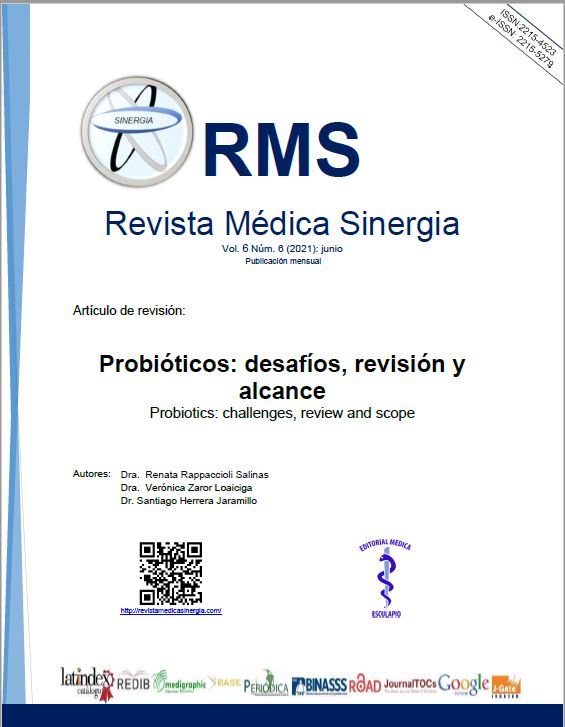Abstract
Probiotics are non-pathogenic live microorganisms with beneficial effects on the health of the host. The most widely used species and strains can be part of the composition of different types of products, including food, drugs and dietary supplement that survive in the transit of the gastrointestinal tract. They participate in the prevention and treatment of infectious digestive and liver diseases, autoimmune conditions, intestinal homeostasis, bone diseases, among others.
Keywords
References
Surawicz y Lawrence J, Brandt CM. probióticos y transplante de microbiota fecal. En: Sleisenger y Fordtran Enfermedades digestivas y hepáticas, La Ciudad Condal, España: Elsevier Masson, 2017, p 2339-2343, Disponible en: https://www.clinicalkey.es/#!/content/book/3-s2.0-B9788491132110001303?scrollTo=%23hl0000249
Kashyap y Rebecca L. Morgan GAPAVWPC. AGA Technical Review on the Role of Probiotics in the Management of Gastrointestinal Disorders. Gatroenterology . 2020 ;159(2):708–38. Disponible en: https://www.clinicalkey.es/#!/content/journal/1-s2.0-S0016508520347326?scrollTo=%23hl0000395%20
Garrote Antonieta, Bonet Ramon, Probióticos, Elsevier, Marzo 2017, Vol 31. Num 2, páginas 13-16. Disponible en: https://www.elsevier.es/es-revista-farmacia-profesional-3-articulo-probioticos-X0213932417608720
Julio Plaza Diaz, Ruiz Ojeda Francisco, Gil Campos Mercedes, Gil Angel, Mechanisms of Actions of Probiotics, Advances in Nutrition, Volume 10, January 2019, pages S49-S66. Disponible en: https://academic.oup.com/advances/article/10/suppl_1/S49/5307225?login=true
Castañeda Guillot Carlos, Probióticos, puesta al dia, Scielo, Revista Cubana de Pediatría, 2018, Vol.90 no.2. Disponible en: http://scielo.sld.cu/scielo.php?script=sci_arttext&pid=S0034-75312018000200009
Susan Prescott, Christina West, Prebiotics and Probiotics for treatment of allergic disease, Uptodate, jan 22, 2020. Disponible en: https://www-uptodate-com.binasss.idm.oclc.org/contents/prebiotics-and-probiotics-for-treatment-of-allergic-disease?search=probioticos&source=search_result&selectedTitle=4~138&usage_type=default&display_rank=4
Surawicz y Lawrence J. Brandt CM. probióticos y transplante de microbiota fecal. En: Sleisenger y Fordtran Enfermedades digestivas y hepáticas . la Ciudad Condal, España: Elsevier Masson; 2017. p. 2339–2343. Disponible en: https://www.clinicalkey.es/#!/content/book/3-s2.0-B9788491132110001303?scrollTo=%23hl0000249
Food and Drug Administration (FDA). GRAS Notices. 2016 ago. Disponible en: https://www.cfsanappsexternal.fda.gov/scripts/fdcc/index.cfm?set=GRASNotices
Aneska Mariño GarcíaI, Magdalys Núñez Velázquez, Jesús Barreto PeniéII. Microbiota, probióticos, prebióticos y simbióticos. IIServicio de Nutrición Clínica Hospital Hermanos Ameijeiras 2016.
Carlos Castañeda Guillot. Probióticos, puesta al día. Revista Cubana de Pediatría 2018; 90(2):286 -298
Segura Aurora, Que son los probióticos y porque los expertos de Harvard recomiendan su consumo, La Vanguardia, 10 febrero, 2021. Disponible en: https://www.lavanguardia.com/comer/tendencias/20210210/6230728/que-son-probioticos-expertos-harvard-recomiendan-consumo.html
Zanin Tatiana, Probióticos: que son, para que sirven y como tomarlos, Tua Saude dieta y nutrición, Abril 2021. Disponible en: https://www.tuasaude.com/es/que-son-los-probioticos/
American Gastroenterological Association (AGA). Choosing the right probiotics. Gastro.org. 2020. Disponible en: https://gastro.org/practice-guidance/gi-patient-center/topic/choosing-the-right-probiotics/?hilite=%27probiotics%27
Grace L. Su, Cynthia W. Ko, Premysl Bercik, Yngve Falck-Ytter, Shahnaz Sultan, Adam V. Weizman, and Rebecca L. Morgan. AGA Clinical practice guidelines on the role of probiotics in the management of gastrointestinal disorders. Gatroenterology 2020; 159:697–705
Berkeley N Limketkai, Anthony K Akobeng, Morris Gordon, Akinlolu Adedayo Adepoju, Probióticos para la inducción de la remisión en la enfermedad de Crohn, Cochrane Library 2020. https://doi.org/10.1002/14651858.CD006634.pub3
Ruiz Abellan Maria, Probióticos para regular el estreñimiento, Instituto central lechera asturiana, 28 febrero 2020. Disponible en : https://www.39ytu.com/actualidad/ucam-capsa/probioticos-estrenimiento/
Gabriel Olveira, Inmaculada González-Molero. Actualización de probióticos, prebióticos y simbióticos en nutrición clínica. Endocrinología y Nutrición 2016; 63 (9): 482-494
Ballesteros-Pomar MD, González Arnaiz E. Papel de los prebióticos y los probióticos en la funcionalidad de la microbiota del paciente con nutrición enteral. Nutrición Hospitalaria 2018; 35(2):18-26
Castellano Cuesta Juan Antonio, Microbiota Intestinal y Hueso, Rev. Sociedad Val. Reuma. 2017, 7;2:1-4. Disponible en: https://dialnet.unirioja.es/descarga/articulo/6418714.pdf
Wassermann AO. Síndrome Metabólico Definición. Epidemiología. Fepreva.org. Disponible en: http://www.fepreva.org/curso/6to_curso/material/ut_1_2.pdf
Correa ML, Ojeda MS, Lo Presti MS. Consumo de prebióticos y probióticos en relación con marcadores de síndrome metabólico en estudiantes universitarios. Nutrición Clínica y Dietética Hospitalaria [Internet]. 05/2019;39(2):171–82. Disponible en: https://revista.nutricion.org/PDF/LOPRESTI.pdf

This work is licensed under a Creative Commons Attribution-NonCommercial 4.0 International License.
Copyright (c) 2021 Array


